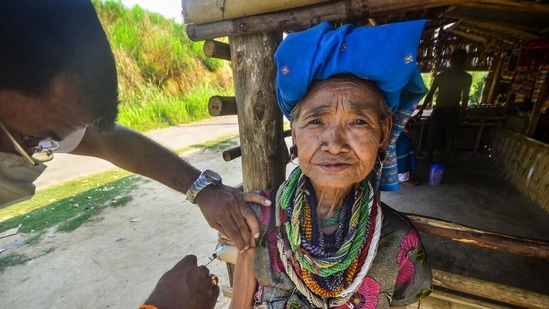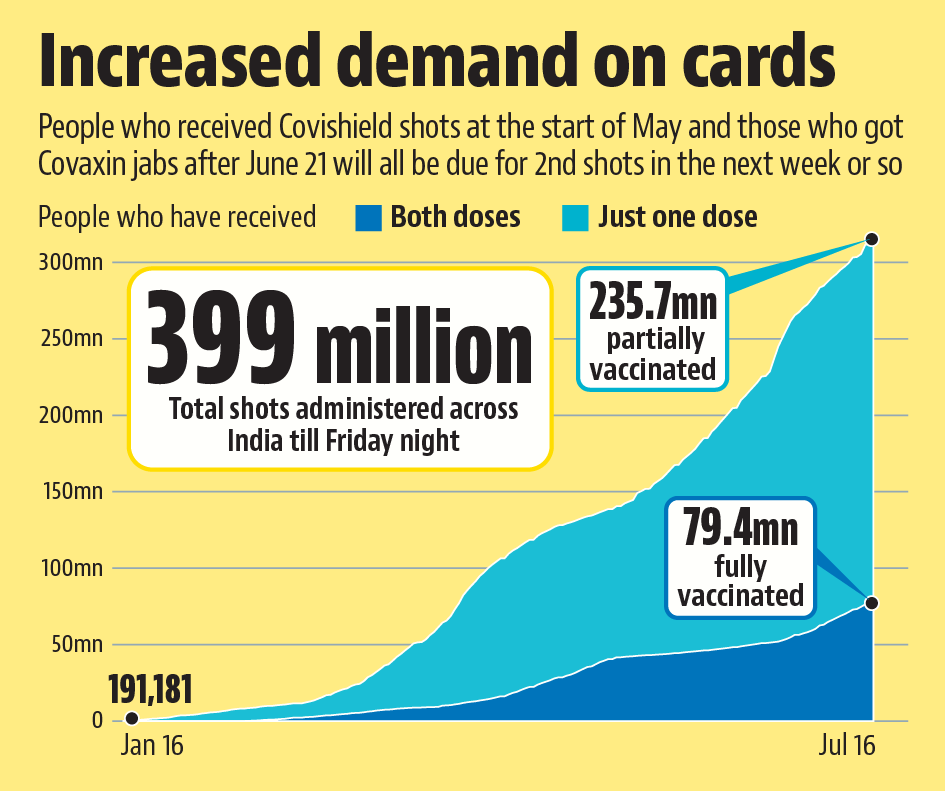India's real vaccination test yet to come, 10 million second doses due from July 21
The pace of daily vaccinations, meanwhile, has been slowing again. On average, 3.8 million shots have been administered every day in the past seven days, a drop of over 40% from the peak levels witnessed in the country.
India is expected to see a massive rush in the demand for both major Covid-19 vaccines (Covishield and Covaxin) starting as early as the middle of next week of July as two significant groups of people – those in the 18-44 age group who received Covishield shots at the start of May when the drive was thrown open for all adults; and those who received Covaxin jabs after the June 21 shift in vaccination policy – become eligible for their second dose almost simultaneously.


The number could be as high as 10 million doses in the week starting July 21, more second doses than have ever been administered in a seven-day period.
The expected jump in demand comes at a time when the states and the Centre have been locked in a war of words over the supply of doses.
Several states have said in recent days that they are facing severe scarcity of doses, and some said they have been forced to close down some vaccination centres.
On Wednesday, Union health minister Mansukh Mandaviya said that vaccine availability in July is 135 million doses.
Till the evening of July 16, nearnearly 64 million doses had been administered in the month.
The pace of daily vaccinations, meanwhile, has been slowing again. On average, 3.8 million shots have been administered every day in the past seven days, a drop of over 40% from the peak levels witnessed in the country.
Of the total 315 million people who have been administered vaccines in India till Friday evening, according to the Centre’s Co-WIN dashboard, 235.7 million have been partly vaccinated (have received one dose), while another 79.3 million are fully vaccinated. This translates into a little over one-third of India’s population eligible for shots having received at least one dose of the vaccine (25% partially vaccinated, and 8.4% having received both doses).
The wide gap between these two groups can be partly attributed to the revision of the prescribed gap between the two doses in the case of Serum Institute of India’s Covishield (a vaccine that accounts for nearly 90% of all doses administered in the country).
On May 13, the Union health ministry announced the widening of the gap between the doses of Covishield from 4-8 weeks to 12-16 weeks. And due to the large proportion of those vaccinated having received Covishield, this change in policy has had a cascading effect on the number of people getting second doses. It ended up having a plateauing effect on the total number of people who were completely vaccinated in the country (see chart) after mid-May, even as more people received first doses.
Till mid-May, the gap between the proportion of people fully vaccinated and those partially vaccinated was closing. At the start of April, only 16% of all the people who received the shots were completely vaccinated. This proportion rose to nearly 30% by May 17, but as the gap between Covishield doses was increased, it started falling again.
To be sure, from the last week of June – which is the corresponding 12-week period from April 1, when the drive was expanded to include everyone over the age of 45 years – the number of people being fully vaccinated has again started rising. This phenomenon is expected to be magnified with an even larger group of people becoming eligible for their second shots starting July 24 (which is 12 weeks since May 1).
The second bump in demand will come from those people who received first jabs of Covaxin from June 21 onwards, when the latest phase of the inoculation drive pushed up vaccination numbers. Since Covaxin has a recommended gap period four-to-six weeks, people in this group will be due for their shots starting July 21.
To be sure, the Union health ministry has not released daily data on the first and second dose breakup of these two vaccines, which makes it difficult to ascertain the exact demand expected for second doses in the coming days. However, a rough estimation can be made based on the nearly consistent 9:1 ratio of Covishield-Covaxin administration. Based on Co-WIN data, around 6.9 million first doses were administered in the first week of May – if we assume 90% of these were Covishield, then around 6.2 million people will be eligible for their second shot in the last week of June. Similarly, 38 million doses were administered between June 21 and June 28 – if 10% of these were Covaxin, then around 3.8 million people may become eligible for Covaxin shots in the week starting from July 21.
This demand, of course, will be in addition to the number of people who will be getting first doses at the same time.
Experts said the situation stressed the need for authorities to be more strategic in using their supplies.
“While the data for mRNA vaccines had showed that delaying second doses, and thus covering more people with first doses, was an effective strategy, I don’t know yet if that is true for our vaccines. Doing so may buy us a little time, but it may also mean that people who are administered one dose end up seeing antibody titer going down to the extent that they may not be protected from Covid. But prioritising second doses risks leaving a larger proportion of population vulnerable to the disease... It becomes very important for the government to not only increase production, but it also puts pressure to be a lot more strategic in using their vaccine supplies,” said Dr Lalit Kant, former head of epidemiology at the Indian Council of Medical Research.






